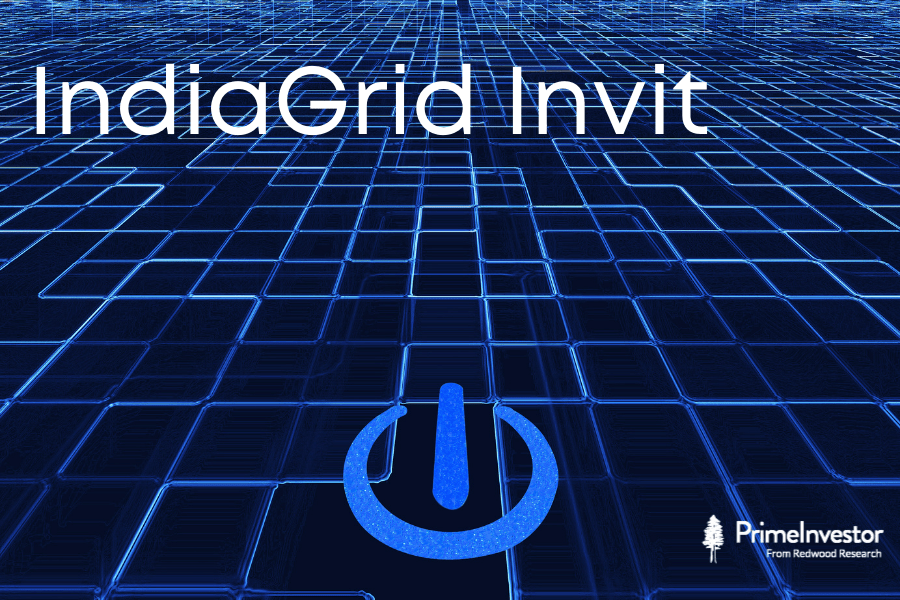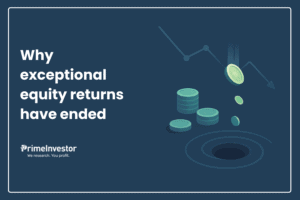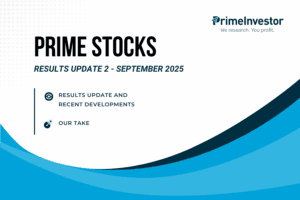IndiaGrid Invit is making a Rs 1,000 crore public issue of secured redeemable Non-Convertible Debentures (NCDs) from April 28 2021 to April 30 2021 to raise money for lending to transmission projects, repaying existing borrowings, and general corporate purposes. This is tranche 1 of a series of such offers.

The Rs 1,000 crore offer consists of a Rs 100 crore initial issue and Rs 900 crore green-shoe option. 40% is reserved for retail investors, 40% for HNIs, 10% for non-institutional investors and 10% for institutions. Allotment however will be on a first come first served basis, and NOT on a proportional basis. The NCDs will be allotted in demat form, with a minimum application size of Rs 10,000 and listed on NSE and BSE.
The interest income on NCDs is clubbed to your income and taxed at your slab rate. Capital gains if any, when NCDs are sold in the secondary market, are taxed based on your holding period (less than one year short term and over 1 year long term).
Need an intro to the concept of Invits? You can read this article to learn more.
Business positives
IndiaGrid is India’s first Infrastructure Investment Trust (Invit) and houses power transmission and renewable energy assets. It was initially promoted by the Sterlite group in 2017. KKR and the Government of Singapore later acquired stakes. In 2020, Sterlite Power sold its 14.7% stake to institutional investors and HNIs, paving the way for KKR to be inducted as the Invit’s sponsor. The Invit today features marquee investors, with KKR owning 23.3%, Government of Singapore 20%, Schroders 6.4%.
Starting with two initial assets, IndiaGrid subsequently acquired 8 new assets from its sponsor and 3 from non-sponsor entities. Today it owns 13 operating projects consisting of 7570 circuit kilometres of 38 overhead power transmission lines and 11 sub-stations. Its assets are pan-India and spread across 17 states and one union territory. Power transmission assets today make up the mainstay of IndiaGrid’s portfolio, but it has plans to diversify into solar and renewable energy from the current 4% to 10-15%.
Invits are governed by SEBI regulations that are similar to those for REITs. In line with these rules, IndiaGrid derives its revenues indirectly from Special Purpose Vehicles which house its assets and distribute 90% of their net cash to the Invit. The Invit in turn has to distribute 90% of its net surpluses after fees and costs, to its unitholders. Given that an Invit’s market valuation is directly derived from its distributions per unit, which in turn rely on the cash generating assets managed, IndiaGrid has been quite aggressive at expanding its portfolio through the acquisition of transmission and recently, solar and renewable assets. Backed by KKR and its significant fund-raising ability, IndiGrid has ramped up its assets from Rs 6,000 crore at the time of listing in 2018 to Rs 20,000 crore in FY21. Equity fund raising through an IPO (Rs 2838 crore), preferential offer (Rs 2514 crore) and a very recent rights issue (Rs 1283 crore) have shored up its equity base.
Given that Invits cannot retain much of their cash flows, growth in their portfolio usually entails higher levels of equity or debt. With IndiaGrid, apart from equity dilution, periodic acquisitions have raised leverage levels too. The acquisition of a transmission asset from Reliance Infrastructure in November 2020, for instance led to its net-debt to AUM shooting up from 52% as of December 2020 to 57%. CRISIL expects this to rise further to 61% after the acquisition of Khargone Transmission from the Sterlite group. However, IndiaGrid has managed to raise its distributions (dividends) to its shareholders despite this. This and the regulatory cap of 70% on an Invit’s leverage, provides a margin of safety to NCD investors.
| Rs cr | FY18 | FY19 | FY20 | 9MFY21 |
| Revenue | 448 | 666 | 1242 | 1176 |
| EBIDTA | 416 | 604 | 1150 | 1061 |
| Net distributable cash flow | 279 | 335 | 720 | 569 |
| Distribution per unit (Rs) | 6.56 | 12 | 12 | 12.1 |
IndiaGrid’s SPVs own inter-state transmission projects operate under a Build-Own-Operate-Maintain model, where customers sign long-term service agreements with them for 25 to 35 years. As it provides an essential service (power transmission), the business offers long-term revenue visibility and doesn’t see too many blips from economic cycles. The fixed charges payable to the SPVs are collected by PowerGrid Corporation, pooled and then paid out based on a fixed formula. The CERC sets the formula on the sharing of transmission charges between users across Indian States. This insulates IndiaGrid’s revenues from volatile electricity tariffs and fluctuations in power offtake.
Risks
While all this offers strong visibility on revenues and cash flows for IndiaGrid Invit, there are risks too.
- One, the annual transmission charge received by each SPV is subject to minimum availability of its grid. If availability falls below a minimum threshold of 98% due to breakdowns, glitches or outages, transmission revenues take a direct hit. IndiaGrid however sets a high bar on operations and maintenance and has been able to maintain it well above the 98% norm.
- Two, State distribution companies (discoms) in India – the final customers for IndiaGrid – are in notoriously poor financial health as States often offer free and subsidized power to many consumer segments, thus incurring large losses. This counter-party risk is mitigated to a large extent by the pooling mechanism with PowerGrid acting as the intermediary for collecting their dues to transmission companies. PowerGrid has traditionally displayed good collection efficiency. But with repeated attempts to reform State discoms failing, delays if not defaults from the discoms cannot be ruled out. In the event they crop up the losses will need to be shared by all the transmission utilities that make up the pool. While this diversifies counter-party risk for IndiaGrid, it also gives it limited control over its collections and cash flows.
- Three, one-off events like the ongoing pandemic can also expose IndiaGrid’s revenues to default risks. CRISIL’s rating rationale notes that PowerGrid’s monthly collection efficiency for instance did dip from over 95% to 50% in April 2020 just after the lockdown, before improving to 95% by December 2020. A second round of lockdowns can lead to a repeat of this episode.
- Four, IndiaGrid’s SPV revenues are heavily dependent on the CERC formula which can be tweaked. During the pandemic for instance, the CERC issued an order, directing a waiver of late payment surcharges from discoms. As interest payments for NCDs need to come out of SPV and IndiaGrid cash flows, the counter-party risk from discoms is a risk to NCD holders too.
Apart from these business risks, the regulatory cap on retaining cash, the need for periodic leverage and the fairly low debt service coverage ratio with which Invits operate present risks to NCD holders.
Ratings
Both CRISIL and India Ratings have accorded the highest AAA rating to the IndiaGrid NCD issue. But NCD buyers should note that these ratings could change, should business and financial risks highlighted above materialize.
What’s on offer
The bonds, offered for tenures of 3, 5, 7 and 10 years pay annual interest. The 7- and 10-year bonds alone have a quarterly interest payout option as well. In a unique feature, investors will be paid a one-time incentive on their principal at the rates mentioned below if they still hold the bond on the record date specified after one year (that is, they didn’t sell it in the secondary market before this date). Do note though that this will only add to your returns in the first year and not thereafter.
The bond offers different interest rates for institutional and individual investors. The rates for individual investors for different tenures are captured below.
| Series of bond | 1 | 2 | 3 | 4 | 5 | 6 | |
| Tenure Years | 3 | 5 | 7 | 7 | 10 | 10 | |
| Interest frequency | Annual | Annual | Annual | Quarterly | Annual | Quarterly | |
| Coupon rate (% pa) | 6.75 | 7.60 | 7.90 | 7.69 | 8.20 | 7.97 | |
| One time incentive % | 0.05 | 0.10 | 0.15 | 0.15 | 0.20 | 0.20 |
Which option?
Given the above facts, here’s are key factors for investors to consider while choosing their NCD option.
#1 Only for income seekers
This NCD offers only an interest payout option and not a cumulative option. Therefore, it is more suitable for income-seeking than growth seeking investors.
#2 Not for long term
At a 7.9% coupon for 7 years and 8.2% coupon for 10 years, the AAA rated IndiaGrid NCD offers attractive spreads versus the market yield of 6.05% for a 10-year government security. Usually, market spreads for AAA bonds range between 60-100 basis points. But buying very long-dated bonds carrying 7 or 10-year tenures today carries the risk of a capital loss from rising rates. Primeinvestor’s view is that long-term interest rates in India will rise from current levels of 6.05% on the 10 -ear government security. Rising inflationary pressures, an upbeat global commodity cycle and a massive domestic government borrowing (which will only get bigger post second wave) will lead to pressure on long-term bond prices and a rise in rates. Today, RBI is keeping rates artificially suppressed through market purchases such as G-SAP. But this cannot work for too long, if market forces pull in the opposite direction. The lack of compounding on the NCD also makes it a sub optimal long-term option. Therefore, we think investors can stay off these long-dated bonds.
| How spreads compare | G-sec yield % | NCD coupon % | Spread bps |
| 3 year | 4.5 | 6.75 | 225 |
| 5 year | 5.77 | 7.6 | 183 |
| 10 year | 6.05 | 8.2 | 215 |
As of April 26, 2021
#3 Choose 3-5 years but only after other options
Both 3 and 5-year NCDs from IndiaGrid are attractive at coupons of 6.75% and 7.60% and spreads of 180-225 basis points over comparable g-secs. Income-seeking investors can go in for these options.
Investors should note that these NCDs are much riskier than the small savings schemes (which are government guaranteed while IndiaGrid is a private entity). Given IndiaGrid’s exposure to the power sector, the NCDs are also riskier than fixed deposits with top notch NBFCs such as HDFC or Sundaram Finance which are RBI-regulated and have a multi-decade record of servicing deposits. For income seekers, options such as Post Office 5-year time deposit (6.7%), Monthly Income Account (6.6%) and Senior Citizens Savings Scheme (7.4%) are better than IndiaGrid NCD.
However, if you have exhausted these, IndiaGrid’s 3 and 5-year NCDs are certainly a good option.





7 thoughts on “IndiaGrid Invit NCDs – Bonds for the short haul”
Taxation of NCD’s when sold in capital markets, you have mentioned within 1 Year Short-Term , Post -1 Year Long Term. Kindly check whether it is correct & update accordingly, as according to me it will follow debt taxation of more than 3 Years Long Term with indexation and within 3 Years Short-Term completely add to income. Thank You.
It is correct. The 3 year holding applies to unlisted securities
Excellent writeup. Thank you
Thanks for quick update, which I had requested for.
Well balanced article. Useful for taking decision.
Hello Madam, Could you please provide a brief opinion on PowerGrid Invit IPO? Thanks!
Covering it tomorrow
Thanks for this well explained write up
Comments are closed.